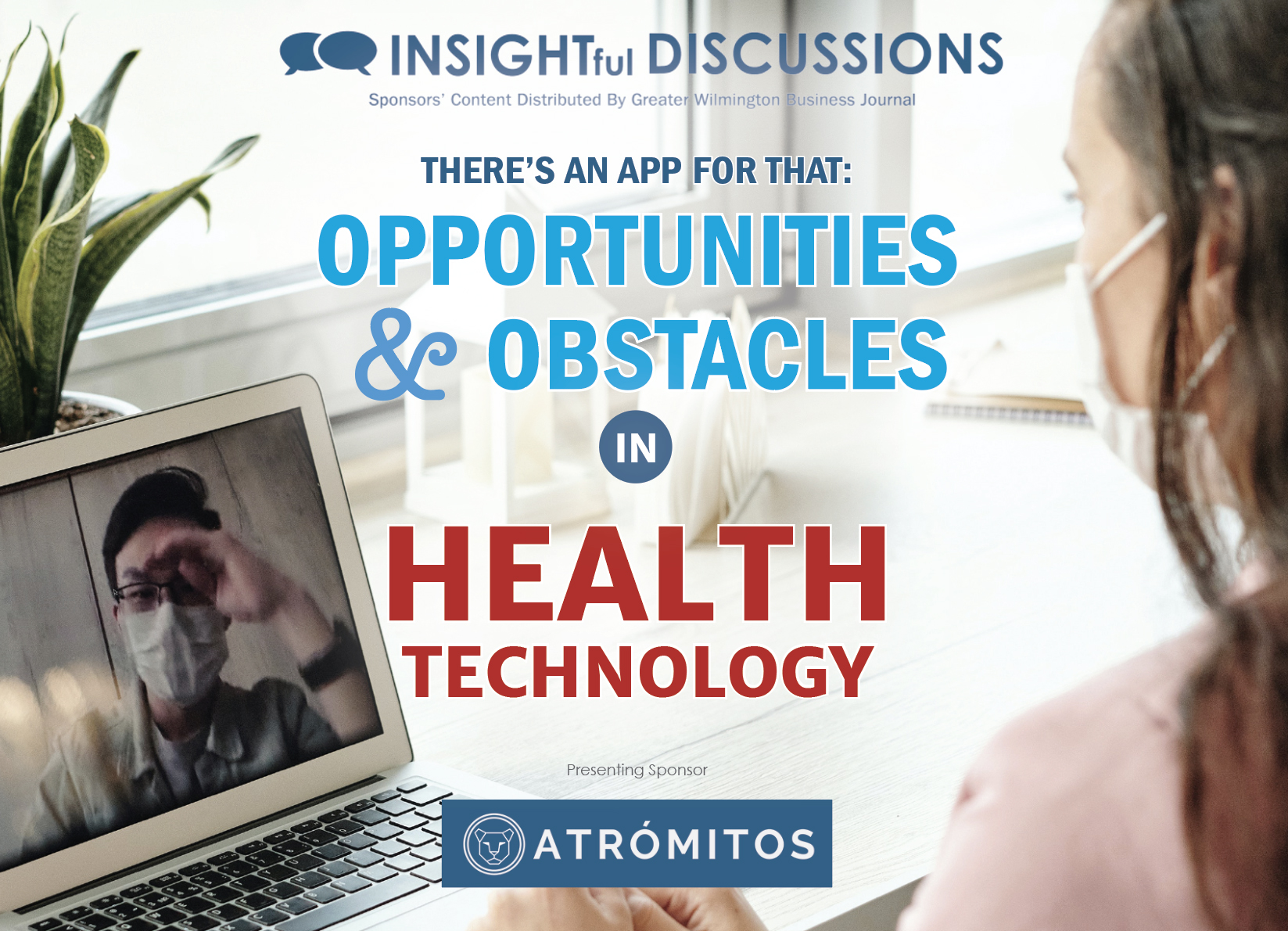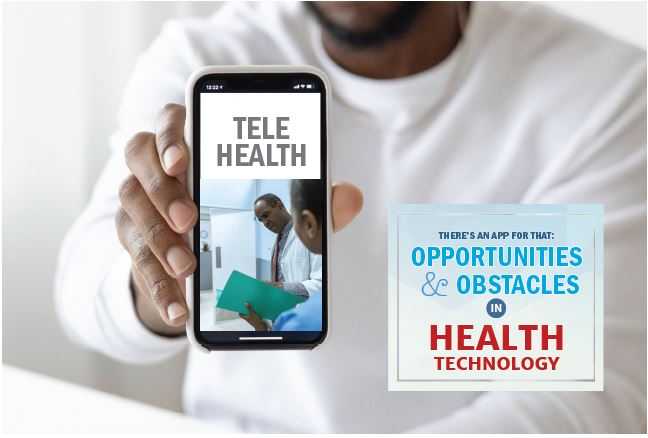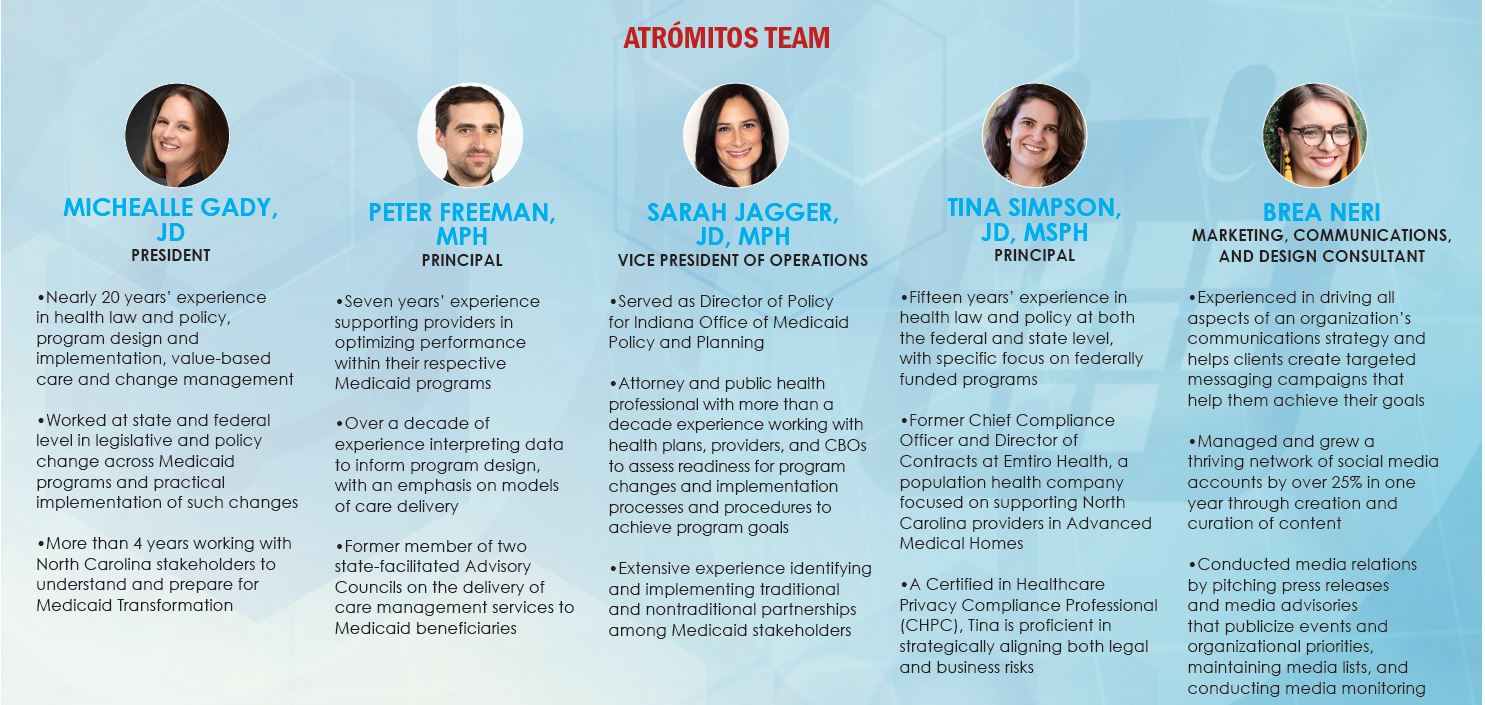
Atrómitos is honored to have sponsored the Insightful Discussion “There’s an App for That: Opportunities and Obstacles in Health Technology.” We are grateful to the panel that participated in this important and timely discussion. Click here to watch the webinar.
Technology has long played an integral role in healthcare. Primarily, it has been leveraged by clinicians through advancements such as X-rays, MRI machines, and medical lasers. The early 2000s saw a wave of technology improvements through electronic health records, which allowed for better organization of patient data and made information (theoretically) easier to share between clinicians. Since March 2020, the availability and use of telehealth services has exploded. In response, we have seen rapid policy changes at the federal and state level to accommodate telehealth in meeting patient needs during the COVID-19 public health emergency
While all of these technologies benefit patients, they exist primarily to enable clinicians to deliver healthcare more efficiently and to more people.
Over the last few years, we have seen a growing use of technology that is focused on enabling patients to meet their health and wellbeing needs where they are and when they are ready to do so. This trend is driven in large part by mobile technology, in particular mobile applications or “apps.” This is a revolutionary opportunity that can place patients in the driver’s seat when it comes to the management of healthcare. However, it also brings with it some new risks. Balancing between the two represents a challenge for regulators, patients, providers, and industry stakeholders.
At Atrómitos, we see this technology as a great leveler; driving equity in access and improved health and wellbeing for individuals and our communities. But the obstacles and barriers must be overcome. Technology companies—and those who invest in them—need to understand the healthcare market and meet patients where they are, rather than taking a “if you build it, they will come” approach. The team at Atrómitos offers over 70 years collective experience in healthcare policy, regulation, management, operations, and innovation. When navigating new waters, it is important to have a partner you can trust. We are passionately and fearlessly committed to helping you do big things and would be honored to support you through this time of tremendous opportunity.

When we think about advancing healthcare in the United States, the conversation frequently shifts to innovation and technology. Advancements in technology over recent years have touched every industry sector and healthcare is no exception. For telehealth in particular, the COVID-19 pandemic was a catalyst for accomplishing almost overnight what normally would have taken years. The widespread adoption of this remote audio-video experience with a healthcare provider proved integral to ensuring continued access to healthcare from the comfort and convenience of your home. Now, domestically, the telehealth field is estimated to be valued at around $111 billion annually by 2025.
Technology represents not only an opportunity to expand access, but to improve quality and outcomes and enhance a patient’s autonomy and control of their healthcare. This is particularly true as it relates to consumer-facing mobile health (mHealth) applications. The spectrum of technology is focused on consumers—from addressing loneliness to acute primary care needs the very moment the patient realizes they need care. This ability to use mobile healthcare technology to bring access to scale in an effort to reach more people is the common goal of using application-based technology in a healthcare setting.
While this is revolutionary from the perspective of helping achieve healthier communities, and helping individuals achieve their best health and wellbeing, there are significant barriers to the adoption and integration of mHealth applications across care delivery, particularly when it comes to underserved populations.
Last month, the Greater Wilmington Business Journal and Atrómitos partnered to host a panel discussion between six leaders from across the healthcare and technology industry.
The panel offered an opportunity for a frank discussion of the barriers that exist in integrating patient-centered mHealth applications. While the discussion necessarily centered on health technology and the specific regulatory, operational, and technological barriers and opportunities that exist, the conversation continuously circled around the broader theme of transformation and how interdisciplinary partners can work together to achieve a more equitable, efficient, and patient-centered health care experience. Below is an overarching summary of the topics raised in this discussion.
Understanding the Barriers to Adoption for mHealth

Prior to 2020, if you were to ask anyone in health care or technology what they thought was the largest barrier to telehealth use in the United States, the answer would have been unanimous: Reimbursement. Restrictions on reimbursement for telehealth or telemedicine encounters have been commonplace for decades. However, the COVID Pandemic has changed and is likely to continue to change those restrictions. As Dr. Brown succinctly explained, “
We know from our COVID experience that the pace of technological advances has really been held down by reimbursement mechanisms.”
The pandemic was a catalyst for accomplishing what normally would have taken years. Overnight, providers, patients, and payers had to grapple with the logistics of delivering necessary care remotely. The widespread adoption of this remote audio-video care delivery experience proved integral to ensuring continued access to healthcare. It demonstrated what is possible with telehealth and will continue to inform patient choices, payer policies, and provider practices, for the better.
While reimbursement and payment models and incentives continue to be an indispensable component of any strategy to promote telehealth delivery, there are other operational and logistical issues. The first obstacle is fragmentation. Dr. Younggren noted that moving care delivery from the physical provider’s office to a digital space does not (and cannot) magically resolve all of the problems that exist in our health care system. Unfortunately, in our fragmented health care system, access to a complete, current health record of each patient at the point of care is not a given in any health encounter. It is no different for health technology companies, which confront “
the same problems that traditional health systems have around fragmented care…We work really hard to connect all the dots that a patient may come in with…but it is quite challenging even for [a technology company],” said Dr. Younggren.
Improved access to patient data and interoperability among providers is one solution to this problem, but that also comes with its own challenges. While healthcare providers and technology solutions seek to “connect the dots” as it relates to patient data, there are also concerns regarding patient privacy and data security when using technology solutions, as Mr. Freeman observed.
Over the past year, with the passage of Patient Right of Access and Interoperability Final Rules by the Office of the National Coordinator for Health Technology and the Centers for Medicare and Medicaid Services, there has been significant navigational shift when it comes to regulations governing patient data and privacy and balancing that against interoperability. Within all this complexity, it is important that patients are the decision makers, and that they have the information necessary to make those decisions.
Mr. Freeman also noted that any successful integration of an mHealth or telehealth application within traditional care delivery depends upon effectively communicating with patients about their rights and how their data will be used. For this, it is important that it be “
very simple and very plain.” Providers have a responsibility in “
helping our patients understand what is being collected, why [it’s being collected], and where it is going,” particularly when that data is being shared outside of Health Insurance Portability and Accountability Act (HIPAA) covered entities or associates.
Meeting Patients Where They Are
While healthcare technology aims to provide convenience for patients and providers, expanding healthcare services to meet the needs of individuals in rural or underserved areas is another way these new technologies can help. Another lesson learned from COVID is the reality of a deep digital divide across the country that leaves many without the tools necessary to connect with healthcare providers including reliable and affordable access to high-speed broadband internet and access to smart phone technology. Phone and phone number turn-over is one such problem that Dr. Dunham grapples with when it comes to technology delivery to North Carolina Medicaid patients. For example, Ms. Jordan noted that certain pay-as-you-go cell phone service providers automatically change cell phone numbers if customers pay their bill after the due date. This leaves providers unable to contact patients in order to provide follow-up care, ultimately leaving thousands of individuals with inadequate healthcare. “
There is a huge technology gap as well as a stability in technology gap, for lack of a better term,” said Dr. Dunham.
Ms. Jordan explained that Pyx Health, as a smartphone application designed to address loneliness and social isolation, is aware of this “digital divide.” As she acutely observed in the discussion, “
Innovation ignores vulnerable populations.” And that is a problem that she set out to resolve in designing Pyx Health’s platform; building it to the specifications of the Medicaid and low-income populations. This meant minimizing data use and developing work arounds to on-board and transition members who have their phone numbers automatically revoked following a lapsed bill. For Ms. Jordan, it isn’t a question of the glitziest or highest-tech graphics to engage members, but instead relying on deep knowledge of the population served, and the human touch. “
You have to build your technology for where they are at,” she said.
If You Build It…Will they Come?
The next question of course is, if you build and deploy an mHealth or other patient-facing technology solution, how can you best ensure that it is used, and it is effective?
For Dr. Younggren, one of the answers is simplicity and interoperability. Among employers, “
there is such a fatigue around ‘how do we integrate all these different programs and technologies we are using in a way that impacts outcomes because none of them connect.”
As Director of Corporate Health at Live Oak Bank, Mr. McAbee has experience in building “environments of health” and in his experience, it is a question of both built environment and design (“
making the healthy choice the easy choice”), and of a corporate culture that truly supports those values. It is only when employee wellness is supported and valued as an inextricable component and driver of corporate performance that external technology vendors or solutions can be successful. Otherwise, as Mr. McAbee noted, “
I am going to waste a lot of money thinking a vendor is going to solve my problem.”
Conclusions
As was underscored throughout this discussion, mHealth and other technology solutions are not a panacea to our fragmented and too often inefficient and inequitable health care system. However, they are indispensable tools whose time has come.
In 2021, we are at a point of transformation, when the traditional, ‘transactional’ or fee-for service delivery model is shifting into a more value-based payment model. Providers should be able to deliver the care regardless of the medium and the physician or the healthcare provider needs to get reimbursed for that in a way that is sustainable.
Dr. Brown eloquently compared this sometimes slow and painful transition to that of the caterpillar into a butterfly saying: “
This transformation that you are seeing—of which technology is going to be [a] huge [part]—is really underpinned by the transformation of a medical care delivery system to something that we never had, which is a health promotion system.” In this moment, in this discussion and in the actionable steps the panelists outlined, Dr. Brown closed on a hopeful note observing, “
I can almost watch the butterfly emerge from the cocoon.”
Atromitos is an SBA-certified woman-owned business headquartered in Wilmington, NC. Their team, collectively, has approximately seventy years of experience combined working in health law and policy operations and implementation, and their work falls within four particular areas: strategy and innovation, policy and research, fundraising and development, and marketing and communications. Atromitos works with organizations of all shapes and sizes, predominantly in the health and human services sector. Their specialty really is in working with organizations that are going through some form of change — whether it's big or small change, change coming from the inside, or change coming from the outside. Healthcare policy and procedure remains in a constant state of change, but what drives the team at Atromitos is ensuring that communities are achieving their best health and wellbeing.
If we can meet any of your needs, send us an email to [email protected]. We also offer free, 30-minute consultations. Visit us here at www.AtromitosConsulting.com/Contact-Us/Free-Consultation to schedule your free consultation.
Stay connected with us on our Facebook and LinkedIn pages.

 When we think about advancing healthcare in the United States, the conversation frequently shifts to innovation and technology. Advancements in technology over recent years have touched every industry sector and healthcare is no exception. For telehealth in particular, the COVID-19 pandemic was a catalyst for accomplishing almost overnight what normally would have taken years. The widespread adoption of this remote audio-video experience with a healthcare provider proved integral to ensuring continued access to healthcare from the comfort and convenience of your home. Now, domestically, the telehealth field is estimated to be valued at around $111 billion annually by 2025.
When we think about advancing healthcare in the United States, the conversation frequently shifts to innovation and technology. Advancements in technology over recent years have touched every industry sector and healthcare is no exception. For telehealth in particular, the COVID-19 pandemic was a catalyst for accomplishing almost overnight what normally would have taken years. The widespread adoption of this remote audio-video experience with a healthcare provider proved integral to ensuring continued access to healthcare from the comfort and convenience of your home. Now, domestically, the telehealth field is estimated to be valued at around $111 billion annually by 2025. Prior to 2020, if you were to ask anyone in health care or technology what they thought was the largest barrier to telehealth use in the United States, the answer would have been unanimous: Reimbursement. Restrictions on reimbursement for telehealth or telemedicine encounters have been commonplace for decades. However, the COVID Pandemic has changed and is likely to continue to change those restrictions. As Dr. Brown succinctly explained, “We know from our COVID experience that the pace of technological advances has really been held down by reimbursement mechanisms.”
Prior to 2020, if you were to ask anyone in health care or technology what they thought was the largest barrier to telehealth use in the United States, the answer would have been unanimous: Reimbursement. Restrictions on reimbursement for telehealth or telemedicine encounters have been commonplace for decades. However, the COVID Pandemic has changed and is likely to continue to change those restrictions. As Dr. Brown succinctly explained, “We know from our COVID experience that the pace of technological advances has really been held down by reimbursement mechanisms.” 


